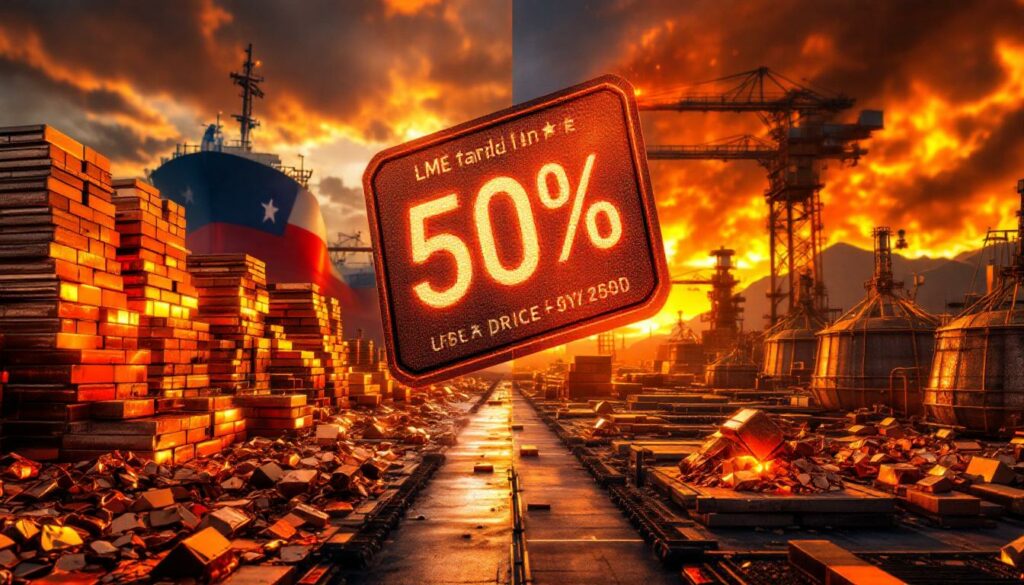What Are the New US Copper Tariffs?
The copper industry has been rocked by the Trump administration's announcement of a sweeping 50% tariff on copper imports in the US. According to Xinhua News Agency's July 8th report, this dramatic policy shift follows the completion of a comprehensive investigation by the US Commerce Department that began in February 2025.
US Commerce Secretary Lutnick confirmed to CNBC that implementation is expected "possibly by the end of July or August 1st," giving markets mere weeks to prepare for this significant trade barrier. The announcement surprised many analysts who had initially predicted a more modest 25% tariff rate.
Understanding the 50% Tariff Announcement
The tariff announcement represents the culmination of a months-long investigation into copper imports that the Commerce Department deemed potentially harmful to US national security interests. The investigation, launched in February 2025, examined both the volume and pricing of copper entering US markets.
Market observers note that the 50% rate is unusually aggressive compared to previous metal tariffs. The rapid timeline from investigation to implementation—roughly six months—also indicates the administration's determination to quickly reshape copper trade dynamics.
"The speed and scale of this tariff implementation signals a fundamental shift in US trade policy toward critical minerals order," notes industry analyst Marcus Chen of Global Metals Review. "Few anticipated such a steep tariff given the manufacturing sector's reliance on affordable copper inputs."
Countries Most Affected by the Tariffs
Chile stands to be most significantly impacted by the new tariffs, as Trade Data Monitor reports the South American nation supplied approximately 70% (646,000 metric tons) of US copper imports in 2024. This heavy dependence on Chilean copper has sparked intense diplomatic negotiations regarding potential exemptions.
According to Citi analyst Tom Mulqueen, "We expect Canada, Chile, and Mexico to eventually get a lower 25% tariff as key trading partners." This assessment acknowledges the strategic importance of maintaining preferential terms with nations that have established trade agreements with the US.
Several factors may influence exemption decisions:
- Existing trade agreement frameworks (particularly USMCA provisions)
- Strategic mineral security partnerships
- Bilateral trade balance considerations
- National security alliances
The US maintains a trade surplus with Chile, which could strengthen Chile's case for exemption or rate reduction. However, the Commerce Department has remained noncommittal about specific exemption criteria, leaving considerable uncertainty in the market.
How Have Copper Prices Responded to Tariff News?
The anticipation and announcement of tariff on copper imports in the US have triggered unprecedented price movements in US copper markets. According to the latest Shanghai Metal Market (SMM) data, COMEX copper futures are trading at a staggering premium of $2,920 per metric ton compared to the London Metal Exchange (LME) benchmark—a historical divergence between these typically aligned markets.
US copper prices had already increased approximately 25% from early January to July 7, 2025, before the final tariff rate was even announced. This price surge occurred as traders positioned themselves for what was initially expected to be a 25% tariff, demonstrating how powerfully tariff expectations alone can drive market behavior.
Record Price Premiums in US Markets
The price bubble created by anticipatory market positioning represents one of the most significant disconnections between US and global copper markets in recent history. The $2,920/mt premium exceeds previous records set during supply disruptions and reflects both actual scarcity and speculative positioning.
This premium manifests differently across various copper products:
- High-grade cathode premiums reaching $3,100/mt in some transactions
- Wire rod commanding 22-28% price increases since January
- Scrap copper prices surging 18% above historical averages
"The US copper market is experiencing an artificial price inflation driven primarily by tariff anticipation rather than fundamental demand," explains metals strategist Sarah Williamson. "This creates both opportunities and risks for various market participants."
Expected Price Normalization
Despite current premiums, analysts widely predict eventual convergence between US and global prices. Tom Price, analyst at Panmure Liberum, states: "Once the global tariff impact related to the US subsides, we expect US copper prices to fall and converge with LME prices."
This normalization process will likely follow several phases:
- Initial premium expansion (current phase)
- Implementation adjustment as actual tariff details emerge
- Inventory release as stockpiled materials enter circulation
- Premium reduction as supply chains adapt to new cost structures
- Eventual equilibrium at tariff-adjusted price levels
The timeline for this normalization depends heavily on exemption decisions, with potential Chilean exclusion representing a particularly significant variable that could accelerate price corrections.
What Supply-Demand Imbalances Have Emerged?
The anticipation of tariffs has triggered extraordinary supply-demand distortions in the US copper market. According to Macquarie analysts cited by SMM, the US imported 881,000 metric tons of copper in the first half of 2025 while domestic demand totaled only 441,000 metric tons—creating a massive 440,000 metric ton surplus.
This artificial surplus represents one of the most dramatic inventory buildups in US copper market history, driven primarily by strategic positioning ahead of tariff implementation rather than actual consumption needs.
US Copper Inventory Buildup
COMEX warehouse inventories have increased 135% since late March 2025, reaching 201,203 metric tons as of July 8th. This rapid accumulation reflects strategic hoarding by traders and industrial consumers seeking to secure pre-tariff copper supplies.
The inventory buildup includes:
- Strategic reserves by major manufacturers
- Speculative positions by commodity traders
- Precautionary stockpiling by downstream fabricators
- Inventory relocation from international to US storage facilities
"We're witnessing unprecedented inventory accumulation driven by tariff avoidance rather than actual demand," notes copper industry consultant Elena Kowalski. "This creates artificial tightness in global markets while simultaneously building a potential oversupply situation in the US."
Global Inventory Shifts
While US inventories swell, global copper stocks have experienced dramatic declines. LME copper inventories decreased 66% from mid-February to approximately 90,000 metric tons by the end of June 2025—reaching their lowest levels since August 2023.
This global drawdown reflects a significant redirection of copper supplies to US markets, creating potential shortages in other regions. Key shifts include:
- Chilean exports pivoting heavily toward US ports
- Asian consumers facing tighter supply conditions
- European fabricators competing for diminished available inventory
- Strategic positioning of copper in US free trade zones for potential re-export
These inventory imbalances highlight the global interconnectedness of copper markets and demonstrate how policy changes in one major market can trigger ripple effects throughout the entire supply chain.
How Is US Copper Demand Trending?
Despite surging prices and inventory accumulation, underlying US copper demand shows concerning weakness. According to Tom Price at Panmure Liberum, US copper demand is forecasted to decline 16% year-over-year to 1.32 million metric tons in 2025—a significant contraction for a material typically associated with economic growth.
This demand deterioration occurs against a backdrop of manufacturing sector contraction, with Price noting that "tariff uncertainty stifles economic growth" as businesses delay capital investments and expansion plans.
Manufacturing Sector Weakness
The US manufacturing sector has shown persistent contraction in recent months, with the Institute for Supply Management's Purchasing Managers' Index (PMI) remaining below the 50-point expansion threshold. This manufacturing weakness directly impacts copper demand across multiple sectors:
- Construction activity declining 8.5% in Q2 2025
- Automotive production cuts at several major manufacturers
- Electrical equipment manufacturers delaying capacity expansions
- HVAC producers reporting 12% lower order volumes
"The uncertainty surrounding tariffs is the main reason for the decline in demand," explains Tom Price. "When businesses can't predict input costs with reasonable accuracy, they postpone major investments and reduce production targets."
Industrial Impact Assessment
Key copper-consuming industries face significant challenges from both price inflation and supply uncertainty. The construction sector, which typically accounts for approximately 43% of US copper consumption, reports project delays and budget overruns due to material cost increases.
The renewable energy sector faces particularly acute pressure as copper represents a critical component in:
- Solar panel infrastructure (4-5 metric tons per MW)
- Wind turbine generators and transmission (2.5-6 metric tons per MW)
- Electric vehicle charging networks
- Grid-scale battery storage systems
"Renewable energy projects with thin margins are especially vulnerable to copper price shocks," notes energy consultant Morgan Zhang. "We're seeing developers delay or redesign projects to minimize copper intensity, potentially compromising performance."
The potential for manufacturing relocation represents a longer-term concern, as producers may shift production overseas to avoid tariff impacts. Several electronics manufacturers have already announced exploratory planning for production shifts to Mexico and Southeast Asia.
What Options Exist for Copper Traders and Stockpiles?
Traders who rushed to position themselves for tariffs now hold some of the world's most expensive copper—metal that could be difficult to sell unless premiums remain elevated. This precarious position has created a complex decision landscape for inventory holders.
Strategic Storage Locations
The geographic positioning of copper inventories significantly affects commercial options and financial implications. Copper stored in US free trade zones (where duty has not been paid) maintains maximum flexibility, as it can be easily exported if market conditions warrant.
By contrast, copper in COMEX warehouses has already been cleared through customs with duties paid, creating different commercial constraints. As Duncan Hobbs, research director at Concord Resources, explains: "There is no reason to think that copper that has been cleared cannot be re-exported… But there needs to be a financial incentive, such as a reversal of the COMEX premium."
Key storage scenarios include:
- Free trade zones: Duty-free storage allowing maximum flexibility for re-export
- COMEX warehouses: Duty-paid metal on warrant, deliverable against futures contracts
- Industrial consumer facilities: On-site inventory for manufacturing needs
- LME warehouses globally: Alternative destination for potential re-exports
The technical distinctions between these storage options create meaningful differences in commercial flexibility and financial exposure.
Trading Strategy Considerations
Traders holding expensive US copper inventory face several strategic options, each with distinct risk profiles:
- Hold for domestic sale: Bet on continued US premium to recover procurement costs
- Re-export when profitable: Wait for COMEX premium reversal to justify shipping costs
- Hedge price exposure: Utilize futures markets to lock in forward prices
- Process into fabricated products: Capture value-added margins to offset high raw material costs
- Arrange swap transactions: Exchange US inventory for foreign metal to arbitrage price differentials
"The optimal strategy depends heavily on individual exposure and market timing," explains commodity trading advisor Jennifer Reid. "Traders with substantial duty-paid inventory face the greatest risk if the premium collapses quickly after tariff implementation."
The financial incentives required for re-export represent a critical decision factor. Currently, the COMEX premium greatly exceeds typical shipping and logistical costs, but any premium compression could rapidly change this calculus.
What Are the Long-Term Market Implications?
The tariff on copper imports in the US, while initially creating short-term market disruptions, will likely trigger fundamental restructuring of global copper supply chains and manufacturing decisions. These adaptations will unfold over months and years as market participants adjust to the new trade landscape.
Global Supply Chain Restructuring
Chile, as the dominant supplier to US markets, faces particularly significant strategic decisions. With 70% of its US-bound exports potentially subject to 50% tariffs, Chilean producers may accelerate diversification toward Asian and European markets.
This redirecting of global copper flows could lead to several adaptations:
- Increased Chilean copper shipments to China and Southeast Asia
- Expanded smelting capacity in tariff-exempt countries to process Chilean concentrate
- Development of more sophisticated swap arrangements to optimize global flows
- Manufacturing relocation to capitalize on regional copper price advantages
"The global copper market will eventually reach a new equilibrium," observes metals economist Patricia Rodriguez. "But the transition period will be marked by volatile price spreads between regions as supply chains reorganize."
Price Forecast Scenarios
The path toward price normalization depends significantly on how exemption policies evolve. According to Citi analyst Tom Mulqueen, if key partners like Chile receive reduced 25% tariffs, US premiums could weaken substantially as supply constraints ease.
Multiple price scenarios are possible:
- Rapid normalization: Generous exemptions trigger quick premium collapse
- Gradual convergence: Moderate exemptions allow orderly inventory drawdown
- Sustained premium: Few exemptions maintain artificial scarcity in US market
- Regional fragmentation: Persistent price disconnections between US and global markets
"The market adjustment timeline will extend through late 2025 at minimum," predicts commodities strategist Michael Chen. "Inventory overhangs typically require 6-9 months to resolve even under normal market conditions."
The most likely outcome involves premium reduction as stockpiled inventory gradually enters the market, with timing dependent on exemption policies and overall economic conditions affecting copper price forecast.
Frequently Asked Questions About US Copper Tariffs
When will the 50% copper tariff take effect?
The tariff is expected to be implemented by late July or August 1st, 2025, according to statements from the US Commerce Secretary Lutnick to CNBC. This rapid implementation timeline gives market participants minimal adjustment time, contributing to current market volatility.
Which countries might receive tariff exemptions?
Analysts suggest Canada, Chile, and Mexico are candidates for reduced tariffs due to their status as key trading partners. Citi analyst Tom Mulqueen specifically expects these nations to receive a lower 25% tariff rate. Chile is particularly significant as it supplies 70% of US copper imports according to Trade Data Monitor.
How have copper inventories changed in response to tariff announcements?
US copper inventories have surged, with COMEX warehouse stocks increasing 135% since March 2025 to 201,203 metric tons, while global LME inventories have decreased by 66% from mid-February to near 90,000 metric tons. This dramatic inventory shift represents one of the most significant global copper reallocations in recent history.
What options exist for traders holding expensive US copper inventory?
Traders can potentially re-export copper if price differentials make it financially viable, store it in free trade zones to maintain flexibility, or sell into the US market if premiums remain elevated. As Duncan Hobbs of Concord Resources notes, re-export requires "a financial incentive, such as a reversal of the COMEX premium."
Comparison: US vs. Global Copper Market Dynamics
| Market Factor | US Market | Global Market |
|---|---|---|
| Price Trend | Sharp increase (+25% YTD) | More moderate growth |
| Inventory Levels | Significant surplus (440,000 mt) | Declining (LME -66% since February) |
| Demand Outlook | Declining (-16% YoY forecast) | Relatively stable |
| Supply Chain | Disrupted by tariff uncertainty | Adjusting to US market changes |
| Price Premium | COMEX at $2,920/mt over LME | Benchmark pricing |
| Future Trajectory | Expected normalization | Dependent on US policy implementation |
This stark contrast between US and global market conditions highlights the potential for arbitrage opportunities while simultaneously creating significant risks for market participants who mistime inventory decisions. The eventual rebalancing of these disparities will define copper market dynamics through 2025 and beyond.
For investors seeking exposure to this sector, exploring opportunities in copper & uranium investment may provide alternative strategies as market conditions evolve. Additionally, Australian investors should consider how the Trump tariff on ASX copper stocks might create both challenges and opportunities in the mining sector.
Market Outlook Disclaimer: The copper market projections discussed in this article involve significant uncertainty related to policy implementation details, exemption decisions, and broader economic conditions. Investors and industry participants should consider multiple scenarios in their planning processes.
Want to Catch the Next Major Mineral Discovery?
Stay ahead of the market with real-time alerts on significant ASX mineral discoveries through Discovery Alert's proprietary Discovery IQ model, which transforms complex mining data into actionable investment insights. Explore how historic discoveries have generated substantial returns by visiting the Discovery Alert discoveries page and begin your 30-day free trial today.




